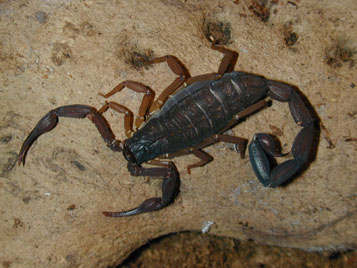Centruroides gracilis
(Latreille,
1804)
|
|

|
|
Common names:
This scorpion is known as the Slenderbrown
scorpion in the US. Also known as Florida Bark Scorpion
and Brown Bark Scorpion.In Cuba this scorpion is known as
"Alacran prieto" (= dusky scorpion) or
"Alacran azul" (= blue scorpion"). From
Latin, the names means "sharp-ended tail-like"
(Centruroides) & "slender" (gracilis).
Distribution:
Africa (Cameroon (introduced), Gabon (introduced)),
(Europa (Canary Islands (introduced)), North America
(Mexico, USA (introduced)), Central America &
Caribbean (Antilles, Cuba (introduced), Guatemala,
Honduras, Martinique (introduced) Nicaragua, Panama
(introduced), Venezuela (introduced)) and South America
(Colombia (introduced), Ecuador, Venezuela).
Habitat:
In natural habitats, this species is found under barks
and stones in tropical forests. In places where this
species is introduced, it can be found inside houses,
under stones and in piles of wood, debris and
sacs, in both indoors & outdoors.
Venom:
This scorpion can inflict very a painful sting,
but it is not considered as potent as some of its
relatives. Some information indicates that individuals
from North America are less venomous than their relatives
from Central and South America. C. gracilis from
Cuba have a reported LD 50 value of 2.7 mg/kg, which is
quite potent. This species should be handled with care.
Selected litterature:
Gaban, R.D. (1998). On: Centruroides gracilis (Latreille).
Forum Forum American Tarantula Soceiety, 7(1), p. 8.
Cao, J., F. Rivera and f. Bello. (1997). Algunos aspectos
bioecologicos y farmacologicos del veneno crudo
procedente de dos especies de escorpiones cubanos.
Resumenes IV Simposio de Zoologia, La Habana; p. 70.
Francke, O. and S. Jones (1982). The life history of Centruroides
gracilis (Scorpiones, Buthidae). J. Arachnol. 10:
223-239.
On the Internet:
Captive Care of the Florida Bark Scorpion (Centruroides gracilis)
General:
Adult males are larger than adult females and have the
same number of instars. In general, males are 50-153mm
and females are 60-100mm. There are several color forms
wich commonly occur together in the same population (even
the same female can give birth scorplings with all these
color forms together in the same litter):
1) Entire blackish animal with deep red hands.
2) Entire reddish animal.
3) Prosoma, mesosoma and metasoma very dark brown, legs
yellowish to reddish brown, pedipalps dark brown witn red
hands & black fingers.
4) Prosoma & mesosoma dark brown with a pale median
longitudinal band, caudal segments I-IV reddish brown,
caudal segment V & telson blackish, legs yellowish,
pedipalps orange brown.
This species is found in some pet collections, both in
US and Europe. Captive breeding have been reported. In
general, this scorpion does very fine in hot (about 30
Celsius degrees) and mesic (not too humid) terraria, set
with plenty of refuges like barks, wood pieces and rocks.
Does not show cannibalistic behavior: can be kept in
groups of 10-20 individuals if food & shelter are
well-provided.
A study show that females mature at the seventh instar
(age around 300 days), while males mature either at the
sixth or seventh instar. Small males mature earlier than
larger males. Attaining maturity at different instar seem
to be a common life-history strategy among buthids.
Littersize 47 (26-91).
Even though post-birth females have been observed
mating, the same female can give birth up to twice a year
after a single insemination.
No current reserach on the species is known.
Centruroides gracilis photo by
Jan Ove Rein (C)
A large part of this species file is writen by Dr.
Rolando Teruel.
|